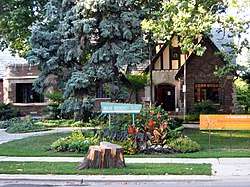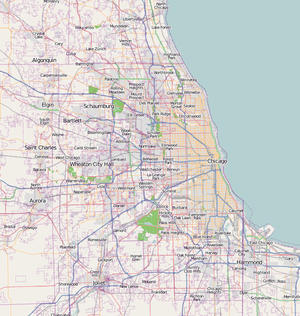Indian Boundary Park
Indian Boundary Park is a 13-acre (5.3 ha) urban park in the West Ridge neighborhood of North Side, Chicago, Illinois.
Indian Boundary Park | |
Chicago Landmark
| |
 Indian Boundary Park Fieldhouse | |
 | |
| Location | 2500 W. Lunt Ave Chicago, Illinois |
|---|---|
| Coordinates | 42°0′34″N 87°41′36″W |
| Area | 13 acres (5.3 ha) |
| Architect | Gloede, Richard F.; Hatzfeld, Clarence |
| Architectural style | Tudor Revival |
| MPS | Chicago Park District MPS |
| NRHP reference No. | 95000485[1] |
| Significant dates | |
| Added to NRHP | April 20, 1995 |
| Designated CL | May 11, 2005 |
History
The park opened in 1922.[2] It is named after a boundary line that was determined in the 1816 Treaty of St. Louis between the Odawa, Ojibwe, and Potawatomi tribes and the United States government. The line ran through the present park.[3]
Former zoo
Indian Boundary Park once had a small zoo,[2] which began with a single American black bear. In later years, it primarily housed farm animals, such as goats, ducks, and chickens.[4] The zoo was maintained by the Zoological Society of the Lincoln Park Zoo.[5] In 2013, the zoo at Indian Boundary Park was closed and the remaining few animals were sent to Lincoln Park Zoo.[6]
Facilities
Indian Boundary Park is noted for its fieldhouse, which was completed in 1929. The design of the fieldhouse incorporates Native American and Tudor elements. In 1989, a large playground was added to the park and assembled with the help of neighborhood residents.[2]
The park was added to the National Register of Historic Places in 1995,[7] and the fieldhouse was named a Chicago Landmark in 2005.[8]
The historic fieldhouse was extensively damaged by a fire on May 20, 2012.[9] Restoration to the fieldhouse began in the late summer of 2013 after extensive negotiations between the Chicago Park District and the insurance provider. It was fully restored on July 14, 2014 with help from the park supervisor, Philip Martini.
References
- "National Register Information System". National Register of Historic Places. National Park Service. March 13, 2009.
- Alice Sinkevitch, et al. AIA Guide to Chicago. American Institute of Architects. 2004. 248.
- Jacque E. Day and Jamie Wirsbinski Santoro. West Ridge. Arcadia. 2008. 7.
- Indian Boundary Park & Cultural Center. Chicago Park District. Retrieved on May 14, 2012.
- "Park History". indianboundaryparkadvisorycouncil.org. Indian Boundary Park Advisory Council. Archived from the original on October 19, 2013. Retrieved May 14, 2012.
- Woodard, Ben (August 30, 2013). "Indian Boundary Park Zoo a Zoo No More". DNAinfo Chicago. Archived from the original on March 2, 2014. Retrieved February 22, 2014.
- National Register of Historic Places in Cook County, Illinois. NRHP. Retrieved on December 15, 2009.
- Indian Boundary Park Fieldhouse Archived 2010-01-07 at the Wayback Machine. City of Chicago. Retrieved on December 15, 2009.
- Bullington, Jonathon (21 May 2012). "Residents vow to rebuild 'treasure' after fire". Chicago Tribune. Retrieved 5 June 2012.
External links
| Wikimedia Commons has media related to Indian Boundary Park. |